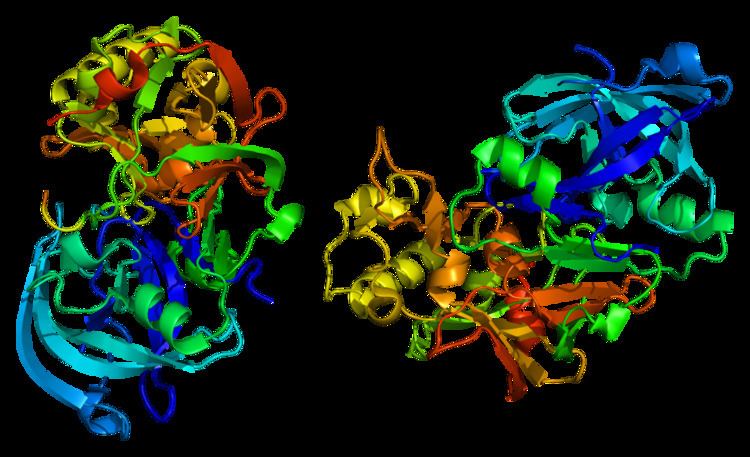Entrez 23621 | Ensembl ENSG00000186318 | |
 | ||
Aliases BACE1, ASP2, BACE, HSPC104, beta-secretase 1 External IDs OMIM: 604252 MGI: 1346542 HomoloGene: 8014 GeneCards: BACE1 | ||
Beta-secretase 1 (BACE1), also known as beta-site amyloid precursor protein cleaving enzyme 1, beta-site APP cleaving enzyme 1, membrane-associated aspartic protease 2, memapsin-2, aspartyl protease 2, and ASP2, is an enzyme that in humans is encoded by the BACE1 gene.
Contents
- Role in Alzheimers disease
- BACE inhibitors
- For Alzheimers disease
- Potential side effects
- Relationship to plasmepsin
- References
BACE1 is an aspartic-acid protease important in the formation of myelin sheaths in peripheral nerve cells. The transmembrane protein contains two active site aspartate residues in its extracellular protein domain and may function as a dimer.
Role in Alzheimer's disease
Generation of the 40 or 42 amino acid-long amyloid-β peptides that aggregate in the brain of Alzheimer's patients requires two sequential cleavages of the amyloid precursor protein (APP). Extracellular cleavage of APP by BACE1 creates a soluble extracellular fragment and a cell membrane-bound fragment referred to as C99. Cleavage of C99 within its transmembrane domain by γ-secretase releases the intracellular domain of APP and produces amyloid-β. Since gamma-secretase cleaves APP closer to the cell membrane than BACE1 does, it removes a fragment of the amyloid-β peptide. Initial cleavage of APP by α-secretase rather than BACE1 prevents eventual generation of amyloid-β.
Unlike APP and the presenilin proteins important in γ-secretase, no known mutations in the gene encoding BACE1 cause early-onset, familial Alzheimer's disease, which is a rare form of the disorder. However, levels of this enzyme have been shown to be elevated in the far more common late-onset sporadic Alzheimer's. The physiological purpose of BACE's cleavage of APP and other transmembrane proteins is unknown. BACE2 is a close homolog of BACE1 with no reported APP cleavage in vivo.
However a single residue mutation in APP reduces the ability of BACE1 to cleave it to produce amyloid-beta and reduces the risk of Alzheimers and other cognitive declines.
BACE inhibitors
Drugs to block this enzyme (BACE inhibitors) in theory would prevent the buildup of beta-amyloid and (per the Amyloid hypothesis) may help slow or stop Alzheimers disease.
For Alzheimers disease
Several companies are in the early stages of development and testing of this potential class of treatment. In March 2008 phase I results were reported for CoMentis Inc's candidate CTS-21166.
In April 2012 Merck & Co., Inc reported phase I results for its candidate verubecestat (MK-8931). Merck began a Phase II/III trial of MK-8931 in December, 2012 estimated to be completed in July 2019. In February 2017, Merck halted its late-stage trial of verubecestat for mild to moderate Alzheimer's disease after it was reported as having "virtually no chance" of working according to an independent panel of experts. This came just three months after Eli Lilly & Co. announced its own setback with solanezumab. The results of Merck's trial of verubecestat on patients with early stage Alzheimer's are still expected in February 2019.
In September 2014 AstraZeneca and Eli Lilly and Company announced an agreement to codevelop AZD3293. A pivotal Phase II/III clinical trial of AZD3293 started in late 2014 and is planned to recruit 1,500 patients and end in May 2019.
Potential side effects
Tests in mice have indicated that BACE proteases, specifically BACE1, are necessary for the proper function of muscle spindles. These results raise the possibility that BACE inhibiting drugs currently being investigated for the treatment of Alzheimer's may have significant side effects related to impaired motor coordination, though BACE1 knockout mice are healthy.
Relationship to plasmepsin
BACE1 is distantly related to the pathogenic aspartic-acid protease plasmepsin, which is a potential target for future anti-malarial drugs.
